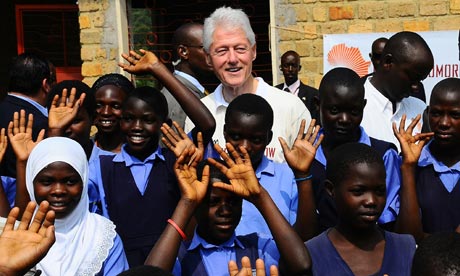
Lack of money can no longer be considered a reason – or an excuse – for failing to treat all those with HIV who need drugs to stay alive, following game-changing work about to be published by the Clinton Foundation that shows the real cost is four times less than previously thought.
The striking findings of a substantial study carried out in five countries of sub-Saharan Africa are hugely important and will set a new hopeful tone for the International Aids Conference in Washington, which opens on Sunday. It will help make the argument for Barack Obama and other international donors to dig deeper into their pockets – because the cost of saving lives, slowing the spread of HIV and achieving the ambition of an Aids-free world is lower than anyone assumed.
The work by the Clinton Health Access Initiative (CHAI) shows that the total cost of treatment in health facilities – including drugs, lab tests, health workers' salaries and other overheads – comes to an average of $200 a patient a year across Ethiopia, Malawi, Rwanda and Zambia – four of the Aids-hit African nations studied. That rises to $682 in South Africa, which has higher salaries and lab costs.
Until now the generally accepted total cost of treating a patient for a year was an average of $880 – based on a study by the US president's emergency plan for Aids relief (Pepfar) released at the last International Aids Conference two years ago in Vienna.
Bernhard Schwartländer, director of strategy at UNAids, believes the CHAI work should lead to new optimism. "I think the cost argument is just a false argument and it has been used as an escape. We do need more money but it is not at a level that will be impossible," he said.
The costings are particularly important in the wake of recent scientific findings that show putting people on antiretroviral drugs makes them far less likely to infect others – helping to stop the spread of HIV as well as keeping people alive. CHAI will also announce that it has negotiated down the prices of some of the newer and most important drugs needed for treatment by around a third.
Former US president Bill Clinton hailed the findings as evidence that all 15 million people with HIV in need of treatment could affordably get it – the target for 2015. At the moment, 8 million are being treated. "We now have compelling evidence that universal access to high-quality HIV treatment is achievable, sustainable, and within our means," said Clinton.
"Together, the costing study and price reductions open the door to scaling up and sustaining services for the 7 million people who currently lack access to HIV treatment. Providing treatment will save lives and help prevent the spread of HIV."
CHAI worked with the Centre for Global Development and the governments of those African countries involved to collect data from 161 health facilities for the last financial year on record – mostly 2010.
The original aim of the study was to find out whether there was any potential to reduce waste, cut costs and save money, but researchers found salaries and other costs were already so low that this was unlikely, except possibly in South Africa.
Average costs per patient were lowest in Malawi, at $136 a year. That rose to $186 in Ethiopia, $232 in Rwanda and $278 in Zambia. Nearly half the cost, on average, was the price of drugs – which will increase slightly as countries begin to use more effective and more expensive drugs now recommended by the World Health Organisation. CHAI, however, is about to announce a deal with generic drug companies, which will reduce tenofovir-based regimens, which are the "gold-standard" in the USA and recommended by the World Health Organisation, to $125 from $339 in 2007. CHAI says this will save countries over $500 million between now and 2015.
Kate Condliffe, executive vice-president for HIV programmes at CHAI, said finances were thought to be a bottleneck to expanding the numbers of drugs in many countries. "The perception that treatment costs are higher is casting a cloud over conversations on how to accelerate treatments," she said.
"You sit through conversations on treatment and prevention where there should be incredible optimism, given the science, and yet there is concern about feasibility and cost that lead to an incremental approach."
But while there are not huge opportunities to save money on treatment in the clinics, there is a disparity between the costs at health facilities and the costs at government level. That was illustrated this week in the major UNAIDS report, which referred to national costs in Zambia – around a third higher than costs in the clinic.
Schwartländer said that even if one assumed a cost of $300 a patient a year, the bill to put 20 million people on HIV treatment would be $6bn a year. "It is not outrageous. It can really be handled," he said. "Look at the amount of money moving around in low-income countries. $6bn should not shock us – it is not impossible. We need a different view from that of the 'treatment timebomb'."

